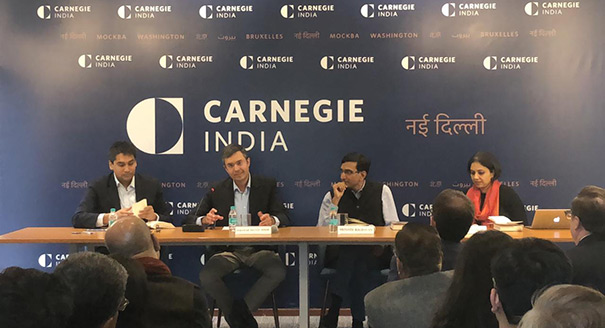Registration
You will receive an email confirming your registration.
The evolution of India’s foreign policy has been shaped by its experience in balancing competing interests during the Cold War. This continues to influence contemporary policy debates as India seeks to shape its role in Asia and the world. In his new book, Power and Diplomacy: India’s Foreign Policies During the Cold War, Zorawar Daulet Singh reconstructs the dynamic worldviews of Indian policymakers through a series of case studies, in order to trace the transformations in India’s foreign policy during the Cold War.
Carnegie India hosted Zorawar Daulet Singh for a discussion on the drivers of Indian foreign policy, based on the book, with Suhasini Haidar, diplomatic editor at the Hindu, and Srinath Raghavan, a senior fellow at Carnegie India. The discussion was moderated by Rudra Chaudhuri, the director of Carnegie India.
Discussion Highlights
- Nonalignment’s Flexibility: Participants acknowledged that historiography on India’s foreign policy during the Cold War has limited its focus to the umbrella concept of nonalignment. While nonalignment represented an unwillingness to partake in formal alliance structures, it did not shackle India’s foreign policy choices, they said. Participants argued that Indian policymakers were acutely conscious of the balance of power during the Cold War period, and responded to it based on their conception of the role India should aspire to play in international politics. Further, they emphasized the importance of examining these role-conceptions in order to understand how policymakers approached questions of national interest, security, and the use of force.
- Nehru and Indira Gandhi Periods: Decisions regarding India’s foreign policy were concentrated in the office of the Prime Minister, participants said. While acknowledging that both Jawaharlal Nehru and Indira Gandhi rejected Indian military involvement in conflicts between other powers, the participants also discussed the significant differences between their foreign policy approaches. They agreed that while Nehru envisioned India as a “peacemaker” within the larger Asian system, Gandhi’s approach was that of a “security seeker,” with a greater focus on the balance of power in the subcontinent. Participants also emphasized the importance of examining India’s foreign policy in the 1950s to understand Nehru’s approach. They noted that Nehru perceived India’s security interests through a wider frame of operation. He sought to accommodate competing international interests–among China, the great powers, and other Asian states–to create a peaceful regional order, they said. Participants went on to discuss the radical shift under Gandhi that prioritized Indian interests in the subcontinent, displayed an inclination toward balance-of-power politics, and a greater willingness to use coercive tactics and force. However, they noted, this did not represent a clean break from past approaches. They added that the deliberations between Gandhi and her advisors, some of whom continued to prescribe to the Nehruvian approach, revealed the tensions between continuity and change.
- Proactive Approach: Participants discussed how the book challenges conventional narratives of Indian foreign policy during the Cold War, which argue that India was only reacting to external developments, such as the Cold War’s bloc structure and the U.S.-Pakistani alliance. They added that by considering, both, deliberations among Indian decision-makers and the alternative decisions they could have made, the book reminds readers that India’s leaders proactively devised India’s role in international politics. Participants emphasized the continued relevance of the questions that Nehru and Gandhi engaged with: whether India should aim to become a great power despite domestic economic underdevelopment, and whether India should use its influence to push for its own interests or resolve problems on the world stage. Participants also asked whether India could aspire to be more than just a part of a “global coalition of rule-makers.”
- Moving Forward: Participants noted that India punched far above its weight during the Cold War by leading the Non-Aligned Movement, which enabled India to be the “voice for the voiceless.” While nonalignment may have prevented power accretion, they stated that India was more concerned about the costs of alignments than its benefits. They emphasized that it is important to study prior patterns of decision-making to guide India’s future choices on the world stage.
This event summary was prepared by Madeleine Sinnis, with inputs from Navya Mehrotra, interns at Carnegie India.
